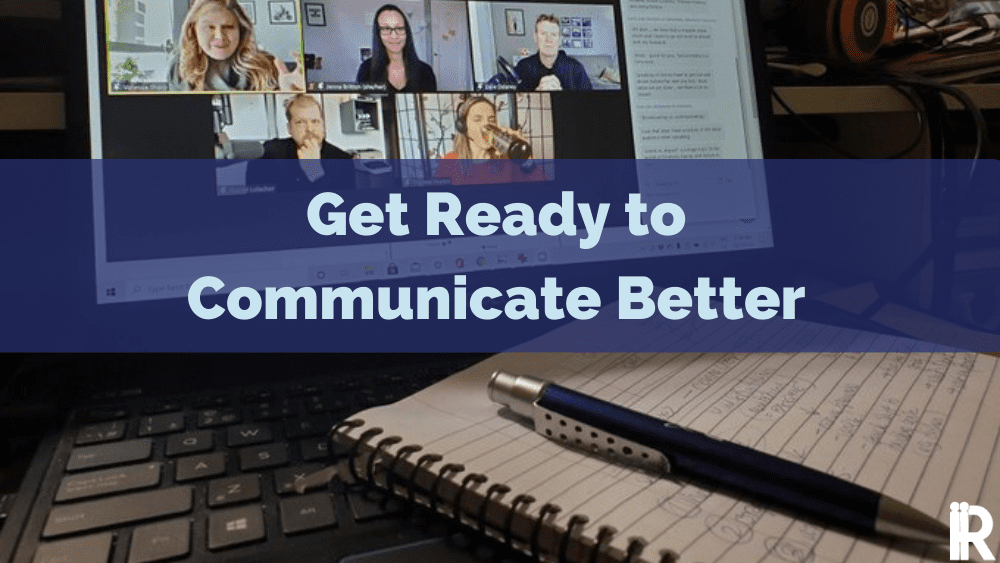Are you ready to be a better communicator? FYI: As a current or aspiring leader, your answer always needs to be YES.
I had the pleasure to speak on the challenges to good communication and tips to improve it at the BIG Ready conference.
The BIG Ready, hosted by the Productivityist Mike Vardy, is an annual event helping attendees to start their year, their project, their hobby, etc. There’s certainly a focus on productivity, but it’s also around the mindset you need to help a person be more productive. Mike invited me to be on his communications panel, with some pretty amazing brains: Jenna Britton, Dr. Therese Huston, and Dave Delaney.
Strong communication skills are vital in becoming a good leader, so I thought you might find value in some of the questions asked and responded to at the event (and some of the things I didn’t get a chance to say):
1. Communication is essential for productivity and our successes, in some form or another, we all struggle with it. Where do you find people struggle the most?
Consistency is a big one. And that consistency is really dependent on the preference of the sender, rather than on what is actually effective for the audience. Do they feel like sending it every week? Is it conversational or corporate in tone? Short and to the point or long and trying to jam all the information in? Should they listen to feedback, and if they do should they respond? To build trust and to save time, commit to a particular tone, frequency, content length and engagement. This way your audience knows what to expect and you can spend less time thinking about how to communicate.
Getting to the point. Save everyone some time and tell people what you need, or need them to know, right off the top. Context and background can come after, either in paragraphs of explanation or in questions asked and answered. People want to help you but shouldn’t have to read or listen to a mountain of information to understand what you want.
Thinking once is enough. People are generally focused on their own tasks and responsibilities. It’s not that they don’t care about your request or information, it’s just that it’s one of many other priorities they’re working on or things they have to remember. If it’s not an urgent task they have to do or know right this minute, it’s sometimes buried in the noise. Don’t think you’re pestering them if you send another message to follow up. They usually appreciate it. Though probably wait a day or so depending on time lines.
2. From your personal experience, what are a few thing that have helped your mindset?
Know yourself. You have biases. We all do because we’ve all had different experiences through life – the bosses we’ve had, how we were raised, the community we grew up in, etc. It all goes to determining our world view. It’s important to understand what your biases are so you can adjust them to more effectively communicate with those you’re trying to reach. Your understanding of issues or topics may not be theres.
Understand our audience. There are two parts to every communication – what you say and what they hear. Anything you communicate is as much about you as it is about the audience you’re trying to connect with. An outside-in mindset, where you consider your audience first (rather than an inside-out one where you just assume you know better) will only help you get your message out and limit the amount of wasted time rethinking and resending your message. I once went through a user experience exercise where one of the pieces of feedback was, “you didn’t write this for me, you wrote this for yourselves.” Ouch.
3. What are some practical tips to improve communication strategies?
Communicate your boundaries. As an extension of knowing yourself, know your limits and communicate them. There’s nothing that wastes time more than dealing with issues that are out of scope of your safe space. What is your available time? What does that time look like (meetings vs work time)? How do you prefer to be communicated with? By putting these in place and letting others know, you’ll be able to be more focused.
Use the tools your audience uses. As part of understanding your audience, understand their preference for communication. I know many organizations think they need to get away from email as a distribution tool, because it’s traditional and not “cool” enough. But if that’s what they want, use it. You just might need to send better emails.
It was an absolutely blast sharing how thoughtful communications can actually save you time and help your productivity. Mike has already announced plans for the next BIG Ready in 2022. I’d highly suggest finding out more if productivity is your thing.
PLUG ALERT!
If you’re looking to increase your trust potential, sign up to my quick, weekly message. It has real world scenarios with actionable solutions, a bit of insight and a mindset reset for those that need it. Subscribe here.






